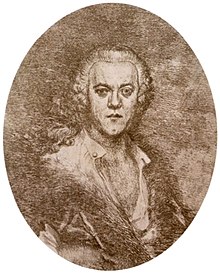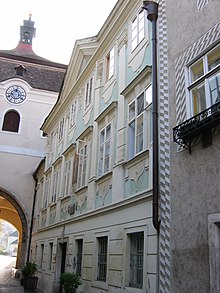Martin Johann Schmidt
Martin Johann Schmidt , called "Kremser Schmidt" , (born September 25, 1718 in Grafenwörth ; † June 28, 1801 in Stein an der Donau ) was next to Franz Anton Maulbertsch the most outstanding painter of the Austrian late Baroque / Rococo . At the same time he is probably the only international baroque painter from Lower Austria .
life and work
He was the son of the sculptor Johannes Schmidt and a student of Gottfried Starmayr . Schmidt spent most of his life in Stein, from where he mainly worked on churches and monasteries in the area. Influences in the work can be found above all from Rembrandt van Rijn , Jacob van Schuppen and the frescoes Paul Troger and Daniel Gran . His house in Stein has been preserved to this day.
Due to personal contacts with the Academy of Fine Arts , he received the first major commissions for the parish church in Stein (1751) and the (today's) Piarist church in Krems an der Donau (1756). Although he had not had any academic art training, he was accepted (as a history painter ) in the Vienna Academy in 1768 - the recordings “Arbitration of Midas” and “Die Schmiede des Vulkan” are now in the Austrian Belvedere Gallery in Vienna. His domain, however, were mainly devotional and altar paintings (for example in the Scheibbs monastery church ). Not least his motifs, some of which are quite popular, made him very popular even during his lifetime. He was also an important draftsman and left numerous etchings . There are echoes of Rembrandt van Rijn .
His pictures are kept in warm light and dark tones, from the 1770s onwards they gained a strong coloring and a color scheme that was unusual for the era. In it they remind of Franz Anton Maulbertsch. While Maulbertsch found himself established in classicism in his late work , Schmidt remained committed to the late Baroque image conception until the end. This also corresponds with an increased personal religiosity at this time.
In the 1780s he dealt again with mythological motifs and genre scenes . Schmidt's private passion was Dutch painting in the 17th century. Without commission, he created genre scenes and character heads in the Dutch style on paper after Rembrandt, Ostade, Callot and other artists of this era. These sheets can also be used as templates for the student group. Some of these works were edited by Ferdinand Landerer and published as engravings. This work earned him the nickname of Lower Austrian Rembrandt.
Not least because of his long life, the list of his works is very extensive. The master's main works are in the picture gallery of the St. Paul Abbey in Carinthia . These are mainly large-format pictures - including the famous Last Supper (227 × 391 cm). Smaller works are in large numbers in the Göttweig and Seitenstetten monasteries .
Works
- 1745 image of St. Andreas embracing the cross and 1747 image of Christ in Limbo in the chapel of Goldegg Castle in Lower Austria
- 1749 Side altar painting The scene shows the fall of the bridge of St. John Nepomuk into the Vltava in the parish church of Großweikersdorf at night
- 1750 picture The consecration of the angels of Maria Einsiedeln in the parish church Münzbach
- 1756 High altar picture of the Holy Kinship in the Moritzreith branch church
- 1758 High altar painting Farewell to the princes of the apostles in the parish church in Haindorf
- 1762 Altarpieces and upper images of the side altars in the Maria Roggendorf basilica
- 1763 side altarpiece death of St. Anna with St. Barbara in the parish church of Purgstall
- 1766 side altarpiece death of St. Josef in the parish church of St. Wolfgang near Weitra
- 1768 Altarpiece Glory of St. Nicholas at the former high altar in the parish church of St. Wolfgang near Weitra
- 1768 picture of St. Leopold in the Basilica of Maria Dreieichen
- 1768 Image on the high altar of the Most Holy Trinity in the Neulengbach parish church (Franciscan church)
- 1769 high altar sheet Martyr of St. Lorenz in the parish church Großriedenthal
- 1770 Oberbild Anna Maria teaching in the Welschen Church in Graz
- 1771 high altar picture baptism of Christ parish church in Stiefern
- 1771 high altar painting vision of St. Theresa von Avila in the Carmelite Church in Vienna-Leopoldstadt
- 1771 altarpiece crucifixion of Christ in the parish church of Hirschbach
- 1771/1772/1773 Four side altar pictures in the Franciscan Church of St. Pölten
- 1772 Altarpiece St. Florian saves the burning Stockern Castle in the parish church of St. Vitus in Stockern
- 1772 Altarpiece Saint Martin Belvedere , Vienna
- 1772 High altar painting Angel Fall of the Archangel Michael in the parish church Feldkirchen an der Donau
- 1774 Altarpiece Maria as Queen of Heaven , Stiftskirche Stift Spital am Pyhrn , then transferred to the parish church Rohr in the Kremstal
- 1774 (pages) altarpiece St. Florian saves a burning house in the parish church of Euratsfeld with his prayer
- 1775 (pages) altarpiece Crucifixion of Christ , 550 × 300 cm, pilgrimage church Maria Taferl
- 1775 (pages) altarpiece of the Holy Family , 545 × 300 cm, Maria Taferl pilgrimage church
- 1775 pilgrims in front of Maria Taferl , washed pen drawing, Lower Austria state collections
- 1776 high altar painting St. Nicholas 1777 side altar painting Johannes Nepomuk in the parish church in Herrnleis
- 1779 High altar image of the Nativity in the Rein collegiate church
- 1780 Entombment of Christ Belvedere , Vienna
- 1780 side altarpiece Anna and Maria in the parish church of Deinzendorf
- 1780 high altar painting Martyrdom of St. Andreas in the parish church of Brand near Gmünd
- 1780 Adoration of the Shepherds, Diocesan Museum Graz
- 1782 Annunciation to Maria, Diözesanmuseum Graz
- 1782 Portrait of Pope Pius VI on behalf of the Abbot von Melk
- 1781 Belvedere pub scene , Vienna
- 1781 Musikanten Belvedere , Vienna
- 1782 High altar painting of the Assumption of the Virgin in the parish church of Sankt Gallen
- 1784 Adoration of the Magi Belvedere , Vienna
- 1786 High altar picture of the drowning of St. Florian in the parish church of Wösendorf , both side altar paintings 1790
- 1787 Two side altar paintings of Maria Immaculate and handing over the keys to Peter in the parish church of St. Peter in der Au
- 1788 Venus and Amor Belvedere , Vienna
- 1790 family portrait of Martin Johann Schmidt Belvedere , Vienna
- 1790 Outpouring of the Holy Spirit, Diözesanmuseum Graz
- 1790 David with the harp , painting, Maria Taferl rectory
- 1792 high altar painting baptism of Christ in the parish church of Engstetten
- 1792 high altar painting Martyrdom of St. Stephen in the parish church of Biberbach
- 1794 picture of the washing of feet: Christ in Simon's house in the branch church of St. Wolfgang in Kirchberg am Wechsel
- 1795 High altar picture of the Holy Trinity in the parish church of St. Trinity in Gutenberg on the Raabklamm
- 1796 high altar picture hl. Nikolaus in the parish church Münichreith am Ostrong
- 1796/97 altar leaves in the parish church of Mauthausen
- 1797 Former high altar sheet hl. Nicholas in the parish church of Griesbach
- 1798 Two side altar paintings of the Crucifixion and Baptism of Christ in the Buchkirchen parish church
- 1799 high altar picture Martyrdom of St. Mauritius , fasting image crucifixion , in the parish church of Spitz
- 1799 Last Supper , painting, Maria Taferl rectory
- 1800 Adoration of the Child (Holy Kinship) left side altar picture and Christ on the cross right side altar picture in the parish church of Hafnerbach
- 1775, 1799, 1800, 1801 Pictures in the parish church of Waizenkirchen
Student / workshop
The students of Martin Johann Schmidt continue the oeuvre of their master almost identically, so that it is often difficult to differentiate between the works for both the layman and the expert.
- Anton Mayer (* approx. 1777; † 1852)
- Leopold Mitterhofer
- Andreas Rudroff
- Andreas Kitzberger
literature
- Dworschak, Feuchtmüller, Garzarolli-Thurnlackh, Zykan: The painter Martin Johann Schmidt called "Der Kremser Schmidt" 1718 - 1801 ; Vienna, Austrian State Printing Office, 1955
- Feuchtmüller : The Kremser Schmidt. 1718-1801 ; Monograph and catalog raisonné, Vienna, 1989, ISBN 3-7022-1689-8
- Hans Frühwirth: Your love was for Krems . Cultural Office of the City of Krems, Krems 1997, ISBN 3-901664-01-9
- Karl Garzarolli-Thurnlackh : The graphic work of Martin Johann Schmidt (Kremser Schmidt), 1718–1801 ; Zurich, 1925
- Hermann Arthur Lier: Schmidt, Martin Johann . In: Allgemeine Deutsche Biographie (ADB). Volume 32, Duncker & Humblot, Leipzig 1891, p. 3 f. * Peter Prange: Schmidt, Martin Johann. In: New German Biography (NDB). Volume 23, Duncker & Humblot, Berlin 2007, ISBN 978-3-428-11204-3 , pp. 205 f. ( Digitized version ).
- Constantin von Wurzbach : Schmidt, Martin Johann . In: Biographisches Lexikon des Kaiserthums Oesterreich . 30th part. Kaiserlich-Königliche Hof- und Staatsdruckerei, Vienna 1875, pp. 291–299 ( digitized version ).
Web links
- Entry on Martin Johann Schmidt in the Austria Forum (in the AEIOU Austria Lexicon )
- Literature by and about Martin Johann Schmidt in the catalog of the German National Library
- Entry for Martin Johann Schmidt in the database of the state's memory for the history of the state of Lower Austria ( Museum Niederösterreich )
- The "Kremser Schmidt" artist, citizen and family man article on the website of the Federal Monuments Office
- Works by Martin Johann Schmidt in: Digitales Belvedere
Individual evidence
- ^ Fritz Dworschak et al., Vienna, 1955, p. 96.
- ↑ Dehio Lower Austria north of the Danube 1990 , Moritzreith, Filialkirche Heiligste Dreifaltigkeit, pages 758f
- ^ Krems, Stein and Mauter; Felix Dworschak; 1928; page 12
| personal data | |
|---|---|
| SURNAME | Schmidt, Martin Johann |
| ALTERNATIVE NAMES | Kremser Schmidt; Kremserschmidt; Kremser Schmitt; Kremserschmitt |
| BRIEF DESCRIPTION | Austrian Rococo painter |
| DATE OF BIRTH | September 25, 1718 |
| PLACE OF BIRTH | Grafenwörth , Lower Austria |
| DATE OF DEATH | June 28, 1801 |
| Place of death | Stein an der Donau (now part of Krems ) |




